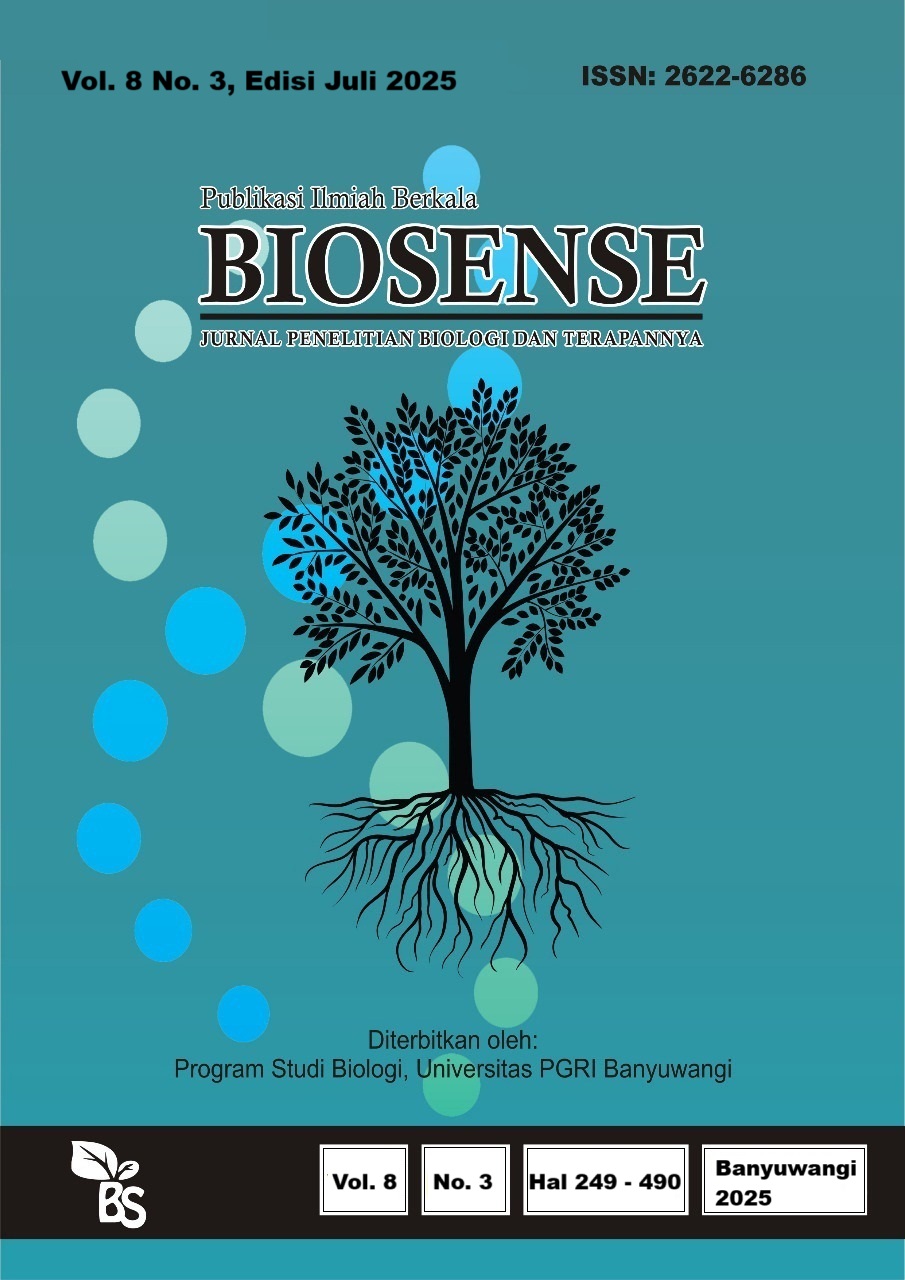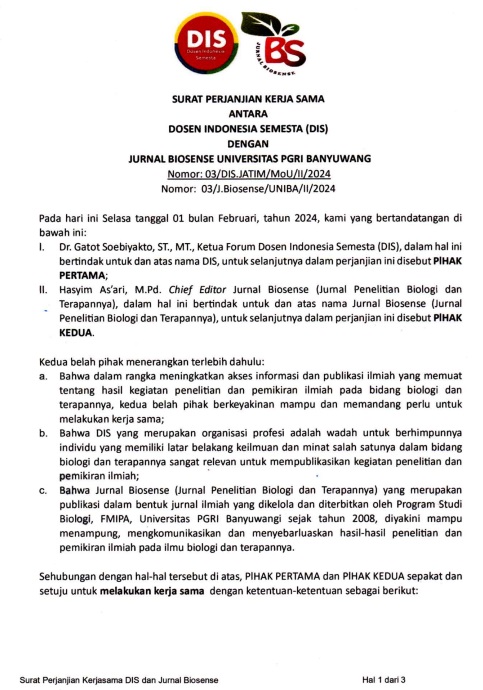OPTIMASI KOMBINASI KAYU SECANG, JAHE, DAN STEVIA DALAM MENINGKATKAN KANDUNGAN TOTAL FENOL
OPTIMASI KOMBINASI KAYU SECANG, JAHE, DAN STEVIA DALAM MENINGKATKAN KANDUNGAN TOTAL FENOL
DOI:
https://doi.org/10.36526/biosense.v8i3.5540Keywords:
kayu secang; jahe; stevia; total fenol; minuman fungsionalAbstract
Tanaman herbal telah lama dimanfaatkan dalam pengobatan tradisional karena kandungan senyawa bioaktifnya, terutama fenol yang berfungsi sebagai antioksidan alami. Di antara tanaman tersebut, kayu secang (Caesalpinia sappan), jahe (Zingiber officinale), dan stevia (Stevia rebaudiana) dikenal memiliki potensi aktivitas antioksidan. Penelitian ini bertujuan untuk mengoptimasi kombinasi ketiga bahan tersebut guna meningkatkan kandungan total fenol dalam formulasi minuman herbal. Pendekatan eksperimen menggunakan metode Response Surface Methodology (RSM) dengan rancangan Central Composite Design (CCD). Proses ekstraksi dilakukan melalui metode infusa pada suhu terkendali, dan kandungan fenol dianalisis menggunakan metode Folin-Ciocalteu dengan spektrofotometer UV-Vis. Hasil analisis statistik menunjukkan bahwa kayu secang memberikan pengaruh kuadratik yang sangat signifikan (p < 0,0001) terhadap peningkatan kadar fenol, sedangkan jahe dan stevia tidak menunjukkan pengaruh yang signifikan baik secara individu maupun interaksi. Model regresi yang dihasilkan signifikan (p = 0,0014) dan sesuai dengan data eksperimen. Grafik kontur menunjukkan bahwa kombinasi konsentrasi menengah antara kayu secang dan jahe menghasilkan kadar fenol tertinggi. Sementara itu, stevia lebih berperan sebagai pemanis alami tanpa kontribusi signifikan terhadap senyawa fenolik. Hasil ini menunjukkan bahwa pengoptimalan proporsi kayu secang dan jahe dapat secara signifikan meningkatkan potensi antioksidan minuman herbal, serta mendukung pengembangan produk fungsional berbasis bahan alami lokal.
References
Almeida, M. B., Silva, R. M., & Ferreira, T. M. (2018). Optimization of natural ingredients using response surface methodology. Food Chemistry, 257, 189–196. https://doi.org/10.1016/j.foodchem.2018.03.013
Boonlert-U-Thai, K., Nopharatana, A., & Limsakul, C. (2015). Design of experiments for functional beverage formulation. Journal of Food Science, 80(4), C702–C708. https://doi.org/10.1111/1750-3841.12826
Fauziah, I. N., & Prangdimurti, E. (2023). Bioaccessibility of antioxidant capacity of Wedang Uwuh by in vitro gastrointestinal digestion. Food and Nutrition Journal. https://dx.doi.org/10.12944/CRNFSJ.11.1.28
Ghosh, S., & Chattopadhyay, P. (2016). Application of RSM in natural product formulation. Journal of Food Processing and Preservation, 40(6), 1320–1328. https://doi.org/10.1111/jfpp.12708
Hossain, M. B., Barry-Ryan, C., Martin-Diana, A. B., & Brunton, N. P. (2018). Bioactive compounds in functional beverages: Extraction, formulation and stability. Journal of Functional Foods, 44, 211–219. https://doi.org/10.1016/j.jff.2018.02.027
Ina, P. T., & Puspawati, G. (2022). Pengaruh penambahan sari kunyit terhadap karakteristik minuman serbuk instan daun belimbing wuluh. Jurnal Ilmu dan Teknologi Pangan. https://doi.org/10.13140/RG.2.2.19783.60328
Indriani, O. D., & Khairi, A. N. (2023). Physico-chemical characteristics of jelly drink with variation of red dragon fruit peel and sappan wood. JAFOST, 4(1). https://doi.org/10.12928/jafost.v4i1.7069
Jayanti, M., Prabowo, S., & Candra, K. P. (2025). Optimasi aktivitas antioksidan minuman herbal celup berbahan bunga telang dan serai. Jurnal Mutu Pangan Indonesia. https://doi.org/10.29244/jmpi.16.1.22-31
Khalafalla, M. M., Osman, S. M., & Farid, M. M. (2020). Design and optimization of process variables using central composite and Box–Behnken designs. Scientific Reports, 10(1), 12345. https://doi.org/10.1038/s41598-020-69232-9
Kumar, A., Sharma, R., & Pathania, S. (2021). Interaction effects of food ingredients: A statistical design approach. Food Bioscience, 40, 100906. https://doi.org/10.1016/j.fbio.2020.100906
Lau, M., Suseno, B. K., & Sudradjat, S. E. (2022). Wedang Uwuh: Minuman herbal kaya antioksidan dari Yogyakarta. https://doi.org/10.37859/jp.v13i2.4552
Li, Y., Zhang, M., & Bhandari, B. (2019). Exploring nonlinear effects in herbal ingredient optimization using RSM. Phytotherapy Research, 33(5), 1311–1318. https://doi.org/10.1002/ptr.6320
Masahid, A. D., Yulianingtyas, R. E., Witono, Y., & Nafi, A. (2023). Physical, chemical, organoleptic characteristics, and antioxidant activity of instant cascara powder with additions of ginger and sappan wood. Agritech, 43(3). https://doi.org/10.22146/agritech.78340
Masahid, A. D., Yulianingtyas, R. E., Witono, Y., & Nafi, A. (2023). Physical, chemical, organoleptic characteristics, and antioxidant activity of instant cascara powder with additions of ginger and sappan wood. Agritech, 43(3). https://doi.org/10.22146/agritech.78340
Montgomery, D. C. (2017). Design and analysis of experiments (9th ed.). Wiley.
Myers, R. H., Montgomery, D. C., Anderson-Cook, C. M. (2016). Response surface methodology: Process and product optimization using designed experiments (4th ed.). Wiley.
Pranata, F. S. (2021). Potensi aktivitas antioksidan ubi jalar dan ekstrak bunga telang dalam pembuatan permen jeli. Pasundan Food Technology Journal. https://doi.org/10.23969/jft.v3i2.4615
Putri, D. K., & Sabila, F. I. (2021). Antioxidant activity from the combination ethanol extract of secang wood and red ginger. Atlantis Press. https://doi.org/10.2991/aer.k.211215.027
Rodrigues, D. B., Fernandes, F. A. N., & Rodrigues, S. (2016). Evaluation of model fit in RSM studies: An application to food systems. Journal of Food Engineering, 179, 79–86. https://doi.org/10.1016/j.jfoodeng.2016.01.003
Rostami, H., Moosavi-Nasab, M., & Tamjidi, F. (2020). Regression models in experimental food design and optimization. LWT - Food Science and Technology, 132, 109979. https://doi.org/10.1016/j.lwt.2020.109979
Septiyani, R., Santoso, U., & Raharjo, S. (2024). The effect of light and temperature on Wedang Uwuh RTD. BIO Web of Conferences, 72. https://doi.org/10.1051/bioconf/202414802008
Septiyani, R., Wikandari, R., Santoso, U., & Raharjo, S. (2024). Brazilin content and antioxidant activity of sappan wood herbal drinks. Thai Interdisciplinary Studies, 19(1). https://doi.org/10.48048/tis.2024.8535
Septiyani, R., Wikandari, R., Santoso, U., & Raharjo, S. (2024). Brazilin content, color stability, and antioxidant activity of sappan wood (Caesalpinia sappan L.) traditional drink by different blanching and drying methods. Thai Interdisciplinary Studies, 19(1). https://doi.org/10.48048/tis.2024.8535
Septiyani, R., Wikandari, R., Santoso, U., & Raharjo, S. (2024). Brazilin content, color stability, and antioxidant activity of sappan wood (Caesalpinia sappan L.) traditional drink by different blanching and drying methods. Thai Interdisciplinary Studies, 19(1). https://doi.org/10.48048/tis.2024.8535
Siregar, T. M., & Neysha, A. (2020). Aktivitas inhibisi α-glukosidase pada minuman fungsional jahe dengan penambahan ekstrak kulit buah naga. FaST-Jurnal Sains dan Teknologi. https://doi.org/10.33541/fast.v9i2.2032
Sudradjat, S. E., Lau, M., & Suseno, B. K. (2022). Wedang uwuh: Minuman herbal kaya antioksidan dari Yogyakarta. MedScientiae.
Surachman, S., & Dewi, Y. S. K. (2022). Ginger (Zingiber officinale) mass ratio on physicochemical and sensory characteristics of liang tea. Gema Agro Teknologi, 4(1). https://doi.org/10.32662/gatj.v0i0.2443
Surachman, S., & Dewi, Y. S. K. (2022). Ginger ratio on physicochemical properties of liang tea. GATJ.
Thakur, M., Goyal, R., & Sharma, P. (2023). Statistical approaches in plant-based beverage formulation: An overview. Journal of Applied Research on Medicinal and Aromatic Plants, 34, 100429. https://doi.org/10.1016/j.jarmap.2023.100429
Tirtayani, L. Y., Ina, P. T., & Puspawati, G. (2022). Pengaruh maltodekstrin terhadap minuman serbuk herbal. Jurnal Ilmu dan Teknologi Pangan. https://doi.org/10.13140/RG.2.2.19783.60328
Widyaningsih, T. D., Nugroho, M. F. A., & Ulilalbab, A. (2022). Optimasi formula Wedang Uwuh berbasis Rosella Merah. Amerta Nutrition, 6(1), 33–42. https://doi.org/10.20473/amnt.v6i1.2022.33-42
Yousefi, M., Emam-Djomeh, Z., & Mousavi, S. M. (2022). Optimization of natural compounds in beverage systems using response surface methodology. Antioxidants, 11(3), 544. https://doi.org/10.3390/antiox11030544
Zhang, H., Chen, Y., & Wang, Y. (2019). RSM application in herbal extraction and formulation. Industrial Crops and Products, 137, 1–8. https://doi.org/10.1016/j.indcrop.2019.04.036
Zhao, Y., Liu, S., & Zhu, K. (2017). Impact of statistical modeling in food science research: A review. Food Research International, 102, 1–10. https://doi.org/10.1016/j.foodres.2017.09.061
Downloads
Published
How to Cite
Issue
Section
License
Copyright (c) 2025 JURNAL BIOSENSE

This work is licensed under a Creative Commons Attribution-NonCommercial-ShareAlike 4.0 International License.

















